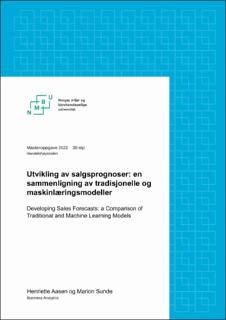| dc.contributor.advisor | Alfnes, Frode | |
| dc.contributor.advisor | Larsgård, Thore | |
| dc.contributor.author | Aasen, Henriette | |
| dc.contributor.author | Sunde, Marion | |
| dc.date.accessioned | 2022-09-21T12:02:23Z | |
| dc.date.available | 2022-09-21T12:02:23Z | |
| dc.date.issued | 2022 | |
| dc.identifier.uri | https://hdl.handle.net/11250/3020213 | |
| dc.description.abstract | Formålet med denne oppgaven er å undersøke og sammenligne om tradisjonelle modeller eller maskinlæringsmodeller gir best resultat når de benyttes til salgsprognoser. Per i dag har ikke E. Sæther AS en standardisert prosess for hvordan salgsprognoser utvikles, noe som gir oss en god mulighet til å utføre en rekke analyser for å finne en modell som på sikt kan tas i bruk av selskapet.
Problemstillingen vi har besvart i denne oppgaven er: “Hvilken prognosemodell bør Sæther ta i bruk til fremtidig prognosearbeid?”. For å besvare denne problemstillingen har vi analysert det ukentlige aggregerte salget i produktkategorien cleanser. Analysene er basert på historisk salgsdata fra januar 2019 til desember 2021.
De tradisjonelle modellene som testes er enkel eksponentiell glatting, dobbel eksponentiell glatting, og trippel eksponentiell glatting, ARIMA, SARIMA og SARIMAX. Maskinlæringsmodellene som testes er Light Gradient Boosting, Random Forest og lineær regresjon. Dataen splittes opp i et treningssett og testsett og modellene sammenlignes ved hjelp av Root Mean Squared Error (RMSE).
Til tross for et enkelt datagrunnlag bestående av 157 observasjoner med historisk salgsdata viser resultatene tydelig at maskinlæringsmodellene i stor grad utkonkurrerer de tradisjonelle når man sammenligner RMSE. Modellen med lavest RMSE er Light Gradient Boosting. Hvorvidt denne modellen kan anbefales for videre arbeid avhenger av tilgjengelige ressurser og kunnskap i Sæther. Dersom modellen implementeres anbefaler vi at den utvides med flere variabler, eller brukes i kombinasjon med dømmekraft. | en_US |
| dc.description.abstract | The purpose of this paper is to compare how classical and machine learning methods perform in sales forecasting. As of now E. Sæther AS does not have a standardized process for developing sales forecast, which gives us the opportunity to perform multiple analysis to find a suitable model that the company may use for future work.
The research question we aim to answer is: “Which forecasting model should Sæther use for future forecasting?”. When performing the analysis, we used the aggregated weekly sales for the product category cleanser. The sales data is collected from January 2019 to December 2021.
The classical models tested consist of Simple Exponential Smoothing, Double Exponential Smoothing, Triple Exponential Smoothing, ARIMA, SARIMA and SARIMAX. For the machine learning we have tested Light Gradient Boosting, Random Forest, and Linear Regression. The data is split into a training and test set, and the models are compared using the Root Mean Squared Error (RMSE).
Despite using simple data consisting of 157 sales observations the machine learning models outperform the classical models. The model with the lowest RMSE is Light Gradient Boosting. Whether this is the optimal model for future work depends on the available resources and knowledge at Sæther. If the model is implemented we recommend extending it with further features, or that it is used in combination with judgmental forecasts. | en_US |
| dc.language.iso | nob | en_US |
| dc.publisher | Norwegian University of Life Sciences, Ås | en_US |
| dc.rights | Attribution-NonCommercial-NoDerivatives 4.0 Internasjonal | * |
| dc.rights.uri | http://creativecommons.org/licenses/by-nc-nd/4.0/deed.no | * |
| dc.title | Utvikling av salgsprognoser : en sammenligning av tradisjonelle og maskinlæringsmodeller | en_US |
| dc.title.alternative | Developing sales forecasts : a comparison of traditional and machine learning models | en_US |
| dc.type | Master thesis | en_US |
| dc.description.localcode | M-ØA | en_US |

